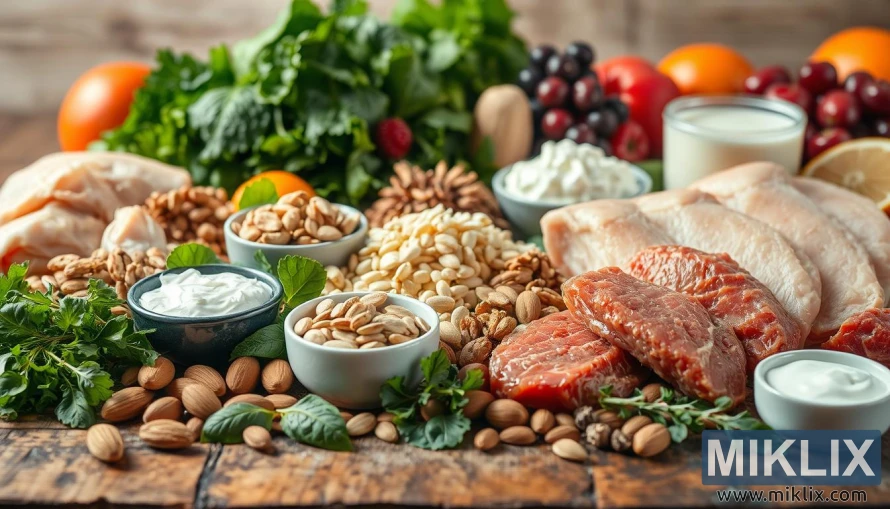Image: Whole Food Sources of BCAAs
Published: July 2, 2025 at 12:30:37 PM UTC
Last updated: September 26, 2025 at 6:02:28 PM UTC
Vibrant still life of BCAA-rich foods like lean meats, nuts, dairy, leafy greens, and fruits, highlighting natural dietary sources for muscle and health support.
The image captures a beautifully arranged still life scene that celebrates the richness of natural food sources abundant in branched-chain amino acids (BCAAs), presenting them with an artistry that evokes both nutritional wisdom and culinary appeal. At the forefront of the display, lean protein staples are carefully positioned across a rustic wooden table, their textures and natural tones emphasized by the soft, natural lighting. Plump cuts of chicken breast, marbled yet lean slices of beef, and delicate fillets of fresh fish form the central foundation of the composition, representing some of the most concentrated and bioavailable dietary sources of BCAAs. Their arrangement suggests both variety and balance, encouraging the viewer to consider the many ways these foods can be incorporated into a nourishing diet.
Interspersed among the proteins are small ceramic bowls and loose clusters of nuts and seeds, each brimming with almonds, walnuts, pumpkin seeds, and other nutrient-dense offerings. These plant-based elements introduce a different yet equally valuable avenue for acquiring essential amino acids, with their earthy textures and rich tones contrasting the smoother, pale surfaces of the meats. Complementing these are servings of dairy in the form of Greek yogurt and creamy cottage cheese, their soft, inviting textures providing a visual counterpoint to the more structured forms of the proteins and nuts. Together, these foods highlight the wide spectrum of choices available for meeting one’s amino acid needs, whether through animal or plant-derived sources.
Moving into the middle and background of the composition, the abundance continues with an array of leafy greens and vibrant fruits. Bundles of spinach and kale stretch across the scene, their deep, verdant hues reinforcing the idea that BCAA-rich diets are not limited to animal proteins alone. Instead, they are part of a larger nutritional tapestry in which vegetables, legumes, seeds, and grains play equally important roles. Among the greenery, bursts of color from ripe tomatoes, citrus halves, and bowls of jewel-toned berries lend the image a sense of vitality and freshness, reinforcing the connection between whole foods and holistic well-being. The carefully blurred but still recognizable background allows these natural foods to stand out vividly while suggesting the environment of a plentiful harvest.
The lighting is gentle yet purposeful, casting a warm glow that emphasizes the natural textures and colors of the ingredients without overwhelming them. The interplay of light and shadow creates depth, allowing the viewer to almost feel the crunch of the nuts, the tenderness of the chicken, and the freshness of the greens. This natural, inviting atmosphere positions the scene not as a sterile scientific display, but as a celebration of the nourishing potential of everyday foods when thoughtfully chosen and prepared.
Beyond its visual appeal, the composition communicates an important nutritional message: branched-chain amino acids, particularly leucine, isoleucine, and valine, are not confined to a single type of food source. Rather, they are found throughout a diverse range of dietary options, spanning meats, dairy, seeds, and vegetables. By presenting these foods together in a single frame, the image underscores the accessibility of BCAAs to people with varied dietary preferences, from omnivores to vegetarians. It suggests that balance, variety, and mindfulness in food selection are key to meeting the body’s needs for muscle growth, repair, and sustained energy.
In its entirety, the still life radiates a sense of abundance, health, and harmony. The rustic wooden surface grounds the display in tradition and authenticity, while the vibrant colors and fresh produce elevate it with energy and vitality. The careful arrangement of proteins, plant-based foods, and dairy products mirrors the balance one strives for in a wholesome diet, conveying that the path to optimal amino acid intake need not be complicated or restrictive. Instead, it is rooted in the rich diversity of foods provided by nature, waiting to be embraced for both their nutritional benefits and sensory pleasures.
The image is related to: BCAA Breakdown: The Essential Supplement for Muscle Recovery and Performance

